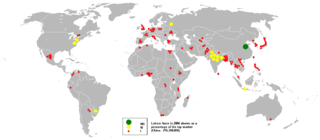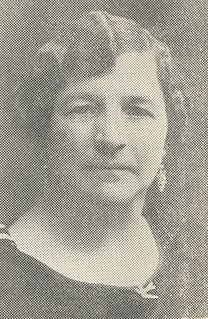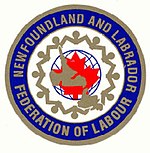A trade union, often simply referred to as a union, is an organization of workers intent on "maintaining or improving the conditions of their employment", such as attaining better wages and benefits, improving working conditions, improving safety standards, establishing complaint procedures, developing rules governing status of employees and protecting the integrity of their trade through the increased bargaining power wielded by solidarity among workers.

The Newfoundland and Labrador New Democratic Party is a social democratic political party in Newfoundland and Labrador, Canada. It is a provincial section of the federal New Democratic Party. It was formed in 1961 as the successor to the Co-operative Commonwealth Federation (CCF) and the Newfoundland Democratic Party. The party first contested the 1962 provincial election. The party won its first seat in the House of Assembly in 1984 and has been represented in the legislature since 1990.

The Canadian Labour Congress, or CLC is a national trade union centre, the central labour body in Canada to which most Canadian labour unions are affiliated.
The Canadian Union of Public Employees is a Canadian trade union serving the public sector – although it has in recent years organized workplaces in the non-profit and para-public sector as well. CUPE is the largest union in Canada, representing some 700,000 workers in health care, education, municipalities, libraries, universities, social services, public utilities, transportation, emergency services and airlines. Over 60 per cent of CUPE's members are women, and almost a third are part-time workers. CUPE is affiliated with the Canadian Labour Congress and is its greatest financial contributor.

The European Trade Union Confederation (ETUC) is the major trade union organisation representing workers at the European level. In its role as a European social partner, the ETUC works both in a consulting role with the European Commission and negotiates agreements and work programmes with European employers. It coordinates the national and sectoral policies of its affiliates on social and economic matters, particularly in the framework of the EU institutional processes, including European economic governance and the EU Semester.

The Australian Workers' Union (AWU) is one of Australia's largest and oldest trade unions. It traces its origins to unions founded in the pastoral and mining industries in the 1880s and currently has approximately 80,000 members. It has exercised an outsized influence on the Australian trade union movement and on the Australian Labor Party throughout its history.
The Miners' Federation of Great Britain (MFGB) was established after a meeting of local mining trade unions in Newport, Wales in 1888. The federation was formed to represent and co-ordinate the affairs of local and regional miners' unions in England, Scotland and Wales whose associations remained largely autonomous. At its peak, the federation represented nearly one million workers. It was reorganised into the National Union of Mineworkers in 1945.

The National Union of Public and General Employees (NUPGE) is a Canadian trade union. Taken in total it is the second largest union in Canada. Most of its 400,000 members work in the provincial public service sector. There is also a large and growing number of members who work for private businesses.
The Canadian Federation of Nurses Unions is a trade union centre in Canada. The CFNU is a federation of provincial unions representing registered nurses, registered psychiatric nurses, registered or licensed practical nurses, nurse practitioners, student nurses and a range of allied health care workers. It advocates on a national level for issues related to nurses, health care and workers.

The Christian Labour Association of Canada (CLAC) is a labour union that represents companies in the construction, healthcare, and food industries. It was established in 1952 to represent workers on the basis of "Christian social principles". The union claims that its approach to labour relations develops workers' sense of responsibility, participation, stewardship, and dignity. It opposes what it calls the undemocratic, adversarial, and monopolistic practices of the labour movement. It has been characterized by other Canadian trade unions for being a "company union" for its support of employer friendly legislation.
The organizations listed below constitute the Canadian Labour Congress, the national federation of trade unions:
Keith Hutchings, is former a Canadian politician in Newfoundland and Labrador. From 2007 until 2019, he represented the district of Ferryland in the Newfoundland and Labrador House of Assembly for the Progressive Conservative Party.
The Fish, Food and Allied Workers (FFAW) Union is a trade union in Newfoundland and Labrador that represents 15,000 workers. Most of the members are in the fishing industry but the FFAW also has organized workers in the hotel, hospitality, brewing, metal fabrication, window manufacturing and oil industries in the province. The FFAW is the largest private sector union in Newfoundland and is affiliated with Unifor.

The United Nurses of Alberta (UNA) is a trade union representing more than 30,000 Registered Nurses, Registered Psychiatric Nurses, and allied health workers in Alberta, Canada. UNA negotiates collective bargaining with the employers, of which the largest are Alberta Health Services and Covenant Health.
The labour movement or labor movement consists of two main wings: the trade union movement or labor union movement on the one hand, and the political labour movement on the other.
Ronald J. Fahey (1905–1952) was a labour leader and politician in Newfoundland. He represented Harbour Main-Bell Island in the Newfoundland House of Assembly from 1949 to 1951.

Nepal has a labour force of 16.8-million-workers, the 37th largest in the world as of 2017. Although agriculture makes up only about 28 per cent of Nepal's GDP, it employs more than two-thirds of the workforce. Millions of men work as unskilled labourers in foreign countries, leaving the household, agriculture, and raising of children to women alone. Most of the working-age women are employed in agricultural sector, contributions to which are usually ignored or undervalued in official statistics. Few women who are employed in the formal sectors face discrimination and significant wage gap. Almost half of all children are economically active, half of which are child labourers. Millions of people, men, women and children of both sexes, are employed as bonded labourers, in slavery-like conditions. Trade unions have played a significant role in earning better working conditions and workers' rights, both at the company level and the national government level. Worker-friendly labour laws, endorsed by the labour unions as well as business owners, provide a framework for better working conditions and secure future for the employees, but their implementation is severely lacking in practice. Among the highly educated, there is a significant brain-drain, posing a significant hurdle in fulfilling the demand for skilled workforce in the country.

Julia Salter Earle (1878-1945) was a noted labour leader and social activist in the early women’s movement in St. John's, the capital city of the Dominion of Newfoundland. She was one of the first women to run for political office in Newfoundland.
The Newfoundland Loggers' Strike was a labor strike in 1958. The strike, led by the International Woodworkers of America (IWA), concerned loggers who campaigned for improved labor and living conditions in logging camps. The strike was unsuccessful and resulted in the IWA being de facto expelled from Newfoundland. The strike has been described as the "most bitter labour dispute in Newfoundland's history."
The right to sit refers to laws or policies granting workers the right to be granted suitable seating at the workplace. Jurisdictions that have enshrined "right to sit" laws or policies include the United Kingdom, Jamaica, South Africa, Eswatini, Tanzania, Uganda, Lesotho, Malaysia, Brazil, Israel, Ireland, the Indian states of Tamil Nadu and Kerala, the Canadian province of Newfoundland and Labrador, and the British overseas territory of Gibraltar and Montserrat. Almost all states of the United States and Australia, as well as the majority of Canadian provinces passed right to sit legislation for women workers between 1881 and 1917. US states with current right to sit legislation include California, Florida, Massachusetts, Montana, New Jersey, New Mexico, New York, Oregon, Pennsylvania, West Virginia, and Wisconsin. A right to sit provision is included in the International Labour Organization's Hygiene Convention, 1964; the convention being ratified by 51 countries as of 2014. Local jurisdictions with right to sit laws include Portland, Oregon, St. Louis, Missouri and London's Royal Borough of Kensington and Chelsea. Some jurisdictions, such as Alabama, Arkansas, Connecticut, Idaho, Kentucky, Maine, Michigan, Missouri, Nevada, New Hampshire, Quebec, and Washington, D.C. have revoked their right to sit laws. Many right to sit laws originally contained gendered language specifying women workers only. Some jurisdictions maintain gendered laws, but many jurisdictions have amended their right to sit laws to be gender neutral.









